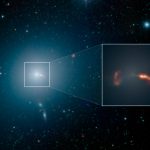
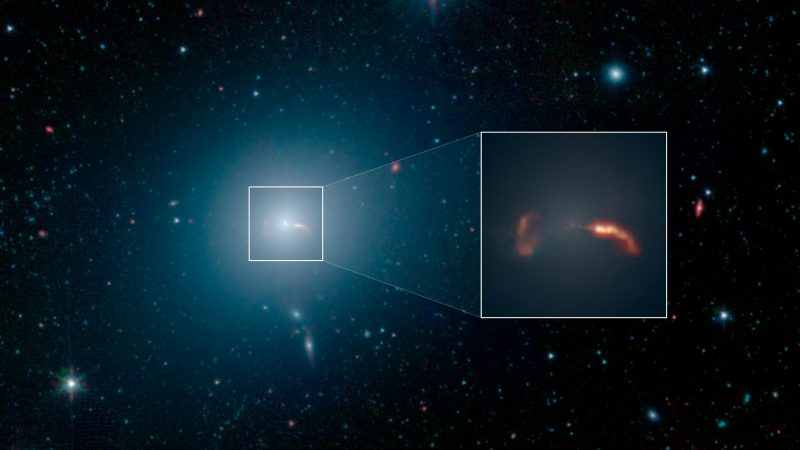
The 1st direct black hole photo came from a galaxy known as Messier 87. Here’s the galaxy’s image from the Spitzer Space Telescope, an infrared telescope launched in 2003 and still operating as of 2019. You can’t see the hole itself in this image, but you can see 2 massive jets of material (and their aftershocks), ejected from the disk of material rotating around the hole. Image via NASA/JPL-Caltech/IPAC.
Earlier this month, scientists unveiled the first-ever photo taken of a black hole. It was a phenomenal achievement, and that image of the hot, glowing donut-shaped ring of gas and dust – surrounding the black hole itself, which can’t be seen – will go down in history as one of the most epic photos in space science. You can thank the Event Horizon Telescope for this first black hole image; this international group worked for years to accomplish it. Now … want some context for the black hole image? The first several images on this page let us step back a bit, to see how the giant black hole – 6.5 billion times more massive than our sun – appears in relation to its host galaxy, Messier 87 (aka M87). It’s a great view!
NASA released the image above – from its orbiting Spitzer Space Telescope – on April 25, 2019. It shows the black hole’s galaxy in the infrared. Although neither the black hole nor its event horizon can be seen here, you can see two massive jets of material being ejected from the event horizon out into space at nearly the speed of light, just one indication of the power of the central black hole. You thought black holes suck in material with gravity so strong that even light can’t escape? That’s true. But other material can become trapped in the disk around a black hole’s event horizon, and later be ejected again back out into deep space.
M87 is very far away – 55 million light-years away from Earth – and has been studied for over 100 years, including by observatories such as the Hubble Space Telescope, the Chandra X-ray Observatory and NuSTAR. The jets were first seen back in 1918, although their connection to a giant black hole was completely unknown at the time. The jets were first noticed by astronomer Heber Curtis as “a curious straight ray” extending from the center of the galaxy. What was this odd feature?
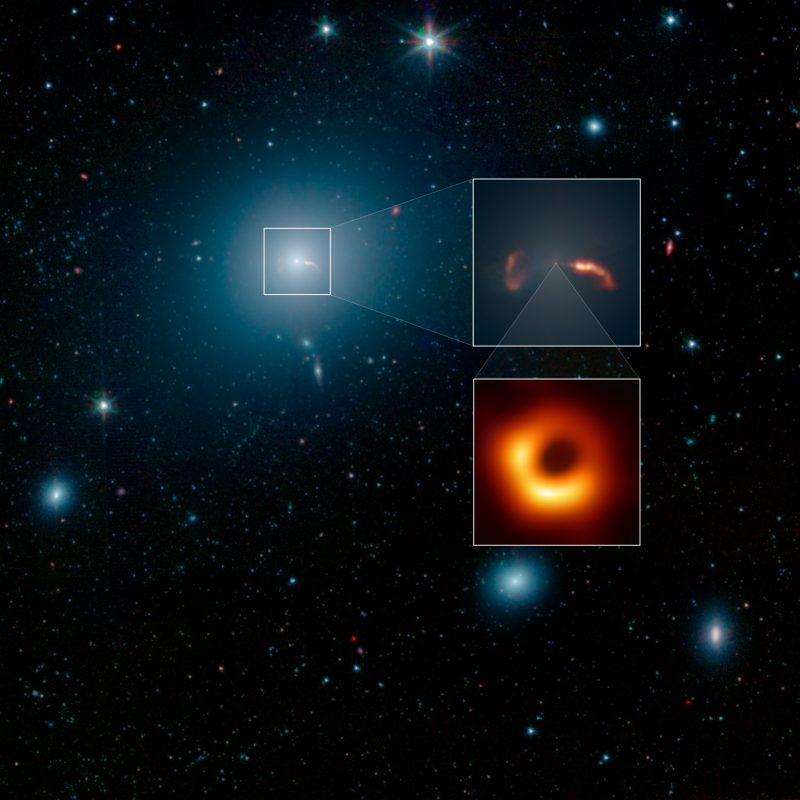
Another version of the first image, also showing the location of the black hole between the two jets. Image via NASA/JPL-Caltech/IPAC/Event Horizon Telescope. Larger versions of these images, including wallpaper, are available via JPL.
Now, we know that the jets are composed of high-energy material that shoots out of a disk of material that spins rapidly around the black hole. The ejected material moves at incredible speed – almost the speed of light – and can be seen in visible light, infrared light, radio waves and X-rays.
One of the jets is quite prominent, but when the material in it hits the much sparser material in the interstellar medium (the space between the stars of the galaxy), it creates a huge shockwave that is even more visible. The shockwave can only be seen in infrared light and radio waves. This jet is moving almost directly toward Earth, which increases its apparent brightness. We can still see some of the length of the jet, however, since it is slightly offset from our line of sight. At one point, it looks like the jet curves downward a bit; according to scientists, this is where particles in the jet hit gas particles in the interstellar medium and slow down a little.

The image that captured people’s imaginations earlier this month – the first real photo of a giant black hole, in the center of galaxy M87. The dark region in the middle isn’t actually the black hole itself, but rather the shadow of the black hole on the bright ring of material. The black hole itself is smaller than the shadow and can’t be seen directly. The bright ring forms as light is bent around the black hole by the intense gravity. Image via Event Horizon Telescope.
The other jet is much fainter, since it is moving away from Earth, and just as fast as the other jet. This makes it virtually invisible in all wavelengths. But as with the first jet, the shockwave – which looks like an inverted letter C – is still clearly visible.
Understanding black holes has been a great challenge for astronomers and physicists over the past few decades, but they’ve been making great strides towards that goal. Once considered to be “exotic,” and still among the strangest objects ever discovered, supermassive black holes are now known to be located in the centers of many (if not most) galaxies, including our own, and an untold number of smaller black holes dot the universe. Studying black holes in the context of their galaxies – and having the ability to image them directly – are major steps towards understanding one of these incredible and bizarre phenomena.
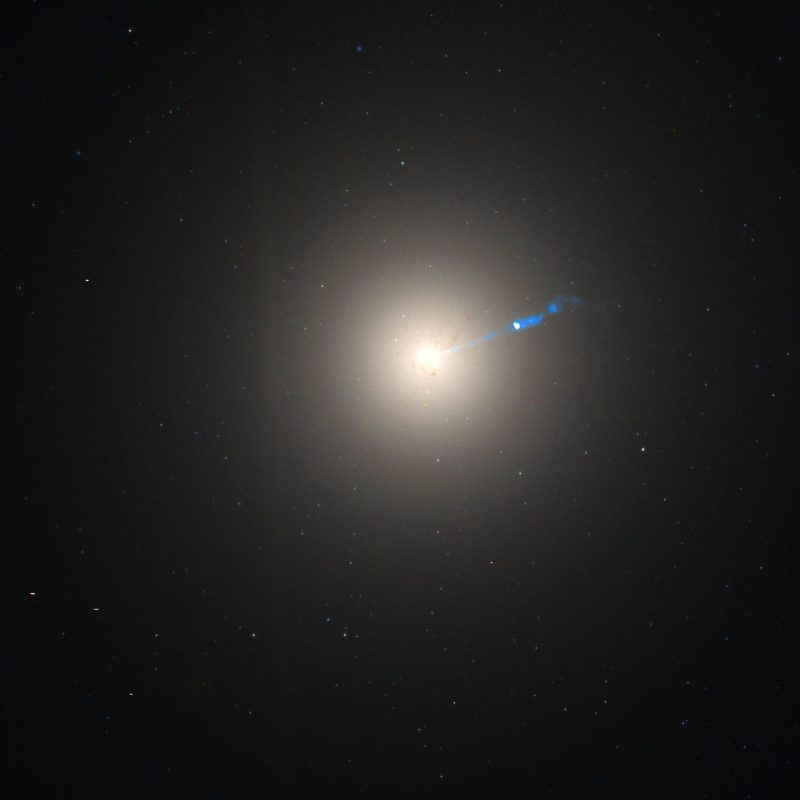
Here’s a classic photo of the galaxy M87, from the Hubble Space Telescope. This image is a composite of visible and infrared observations, and shows the galaxy’s prominent blue plasma jet, streaming from the central black hole at nearly the speed of light. Image via NASA.

Close-up on M87’s jet. It stretches 1,500 parsecs (5,000 light-years) from the galaxy’s core. In this Hubble image, the blue jet contrasts with the yellow glow from the combined light of billions of unresolved stars and the point-like clusters of stars that make up this galaxy. Image via Wikimedia Commons.
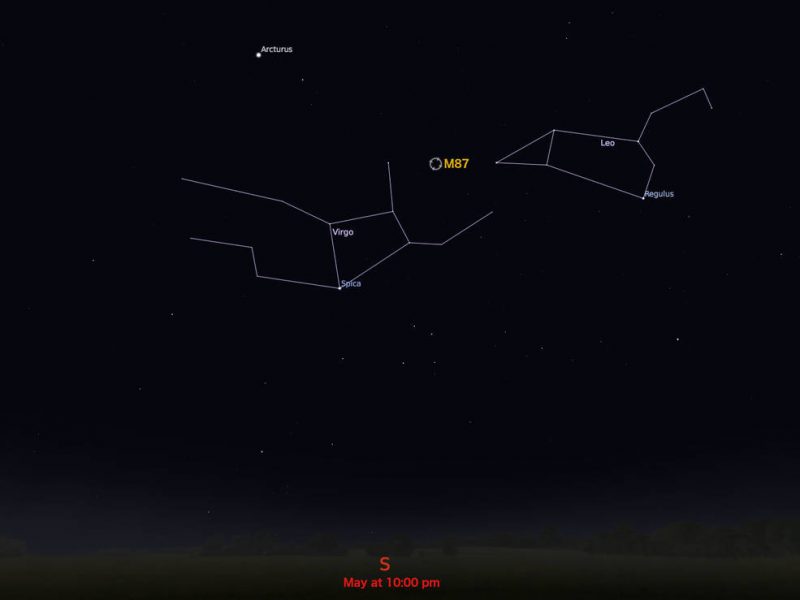
Star chart showing M87 on the sky’s dome, via Stellarium/NASA. This chart represents the view from mid-northern latitudes around 10 p.m. in May. Want to get oriented? Find the stars Arcturus and Spica.
Bottom line: Astronomers have released some new images (first two images on this page) of the galaxy M87, home galaxy to the giant black hole whose image you saw a few weeks ago. The images show you the black hole in the context of its galaxy.
from EarthSky http://bit.ly/2Vy5cjj


The 1st direct black hole photo came from a galaxy known as Messier 87. Here’s the galaxy’s image from the Spitzer Space Telescope, an infrared telescope launched in 2003 and still operating as of 2019. You can’t see the hole itself in this image, but you can see 2 massive jets of material (and their aftershocks), ejected from the disk of material rotating around the hole. Image via NASA/JPL-Caltech/IPAC.
Earlier this month, scientists unveiled the first-ever photo taken of a black hole. It was a phenomenal achievement, and that image of the hot, glowing donut-shaped ring of gas and dust – surrounding the black hole itself, which can’t be seen – will go down in history as one of the most epic photos in space science. You can thank the Event Horizon Telescope for this first black hole image; this international group worked for years to accomplish it. Now … want some context for the black hole image? The first several images on this page let us step back a bit, to see how the giant black hole – 6.5 billion times more massive than our sun – appears in relation to its host galaxy, Messier 87 (aka M87). It’s a great view!
NASA released the image above – from its orbiting Spitzer Space Telescope – on April 25, 2019. It shows the black hole’s galaxy in the infrared. Although neither the black hole nor its event horizon can be seen here, you can see two massive jets of material being ejected from the event horizon out into space at nearly the speed of light, just one indication of the power of the central black hole. You thought black holes suck in material with gravity so strong that even light can’t escape? That’s true. But other material can become trapped in the disk around a black hole’s event horizon, and later be ejected again back out into deep space.
M87 is very far away – 55 million light-years away from Earth – and has been studied for over 100 years, including by observatories such as the Hubble Space Telescope, the Chandra X-ray Observatory and NuSTAR. The jets were first seen back in 1918, although their connection to a giant black hole was completely unknown at the time. The jets were first noticed by astronomer Heber Curtis as “a curious straight ray” extending from the center of the galaxy. What was this odd feature?

Another version of the first image, also showing the location of the black hole between the two jets. Image via NASA/JPL-Caltech/IPAC/Event Horizon Telescope. Larger versions of these images, including wallpaper, are available via JPL.
Now, we know that the jets are composed of high-energy material that shoots out of a disk of material that spins rapidly around the black hole. The ejected material moves at incredible speed – almost the speed of light – and can be seen in visible light, infrared light, radio waves and X-rays.
One of the jets is quite prominent, but when the material in it hits the much sparser material in the interstellar medium (the space between the stars of the galaxy), it creates a huge shockwave that is even more visible. The shockwave can only be seen in infrared light and radio waves. This jet is moving almost directly toward Earth, which increases its apparent brightness. We can still see some of the length of the jet, however, since it is slightly offset from our line of sight. At one point, it looks like the jet curves downward a bit; according to scientists, this is where particles in the jet hit gas particles in the interstellar medium and slow down a little.

The image that captured people’s imaginations earlier this month – the first real photo of a giant black hole, in the center of galaxy M87. The dark region in the middle isn’t actually the black hole itself, but rather the shadow of the black hole on the bright ring of material. The black hole itself is smaller than the shadow and can’t be seen directly. The bright ring forms as light is bent around the black hole by the intense gravity. Image via Event Horizon Telescope.
The other jet is much fainter, since it is moving away from Earth, and just as fast as the other jet. This makes it virtually invisible in all wavelengths. But as with the first jet, the shockwave – which looks like an inverted letter C – is still clearly visible.
Understanding black holes has been a great challenge for astronomers and physicists over the past few decades, but they’ve been making great strides towards that goal. Once considered to be “exotic,” and still among the strangest objects ever discovered, supermassive black holes are now known to be located in the centers of many (if not most) galaxies, including our own, and an untold number of smaller black holes dot the universe. Studying black holes in the context of their galaxies – and having the ability to image them directly – are major steps towards understanding one of these incredible and bizarre phenomena.

Here’s a classic photo of the galaxy M87, from the Hubble Space Telescope. This image is a composite of visible and infrared observations, and shows the galaxy’s prominent blue plasma jet, streaming from the central black hole at nearly the speed of light. Image via NASA.

Close-up on M87’s jet. It stretches 1,500 parsecs (5,000 light-years) from the galaxy’s core. In this Hubble image, the blue jet contrasts with the yellow glow from the combined light of billions of unresolved stars and the point-like clusters of stars that make up this galaxy. Image via Wikimedia Commons.

Star chart showing M87 on the sky’s dome, via Stellarium/NASA. This chart represents the view from mid-northern latitudes around 10 p.m. in May. Want to get oriented? Find the stars Arcturus and Spica.
Bottom line: Astronomers have released some new images (first two images on this page) of the galaxy M87, home galaxy to the giant black hole whose image you saw a few weeks ago. The images show you the black hole in the context of its galaxy.
from EarthSky http://bit.ly/2Vy5cjj

Aucun commentaire:
Enregistrer un commentaire